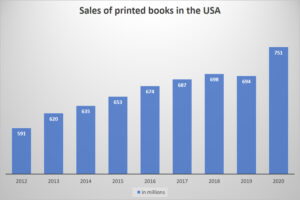
By Andy Fetherman, Muller Martini North America
The North American book market currently is experiencing an actual revival. Despite (or because of) the COVID-19 pandemic, 8.2% more printed books were sold in 2020 compared to 2019.
Without exaggerating, the current positive trend can be described as a revival of the North American book market – and not only in softcover but also in hardcover. So, as a participant at the virtual spring conference of the Book Manufacturers Institute (BMI), which describes itself as the only graphic arts industry association in the US focused on the book manufacturing market, I saw some interesting statistics to support this trend.
23% more books in the first quarter of 2021
A chart entitled “US unit sales of printed books” from NPD BookScan1, which covers 85% of book sales in the US, showed that the number of printed books sold in the US increased from about 694 million in 2019 to about 750 million in 2020. This represents a growth rate of 8.2% – and this was through the pandemic!
The World Economic Forum2 noted that, “readers in the US bought 821 million books last year, putting it 67 million more than in 2020.” It continued to speak towards the impact of social media and how it was a large factor in this growth. “This is especially true about TikTok, through a phenomenon known as ‘BookTok’ where posts featuring its hashtag have received almost 40 billion views.”
While I have yet to see new sales figures regarding the volume of books produced in the current year, I learned from a book manufacturer that he produced 23% more books in the first quarter of 2021 as compared to the previous year. Another book manufacturer instructed its plants to do its maintenance work now to prepare for future volume demands. These are undoubtedly signs of strength for the North American book market.
E-books stagnate
 The fact that during the COVID-19 pandemic many North American book printers experienced, and are still experiencing, striking growth in the production of books is primarily attributed to three specific reasons. First, we are seeing a general flight back to reading printed books (see sidebar on reading print material from Two Sides North America). Secondly, the younger generation is reading more again, which has led to an upswing in books for young people and bodes well for the book market in the long term. Thirdly, volumes in the book-on-demand segment in particular also have strongly increased.
The fact that during the COVID-19 pandemic many North American book printers experienced, and are still experiencing, striking growth in the production of books is primarily attributed to three specific reasons. First, we are seeing a general flight back to reading printed books (see sidebar on reading print material from Two Sides North America). Secondly, the younger generation is reading more again, which has led to an upswing in books for young people and bodes well for the book market in the long term. Thirdly, volumes in the book-on-demand segment in particular also have strongly increased.
The fact that more North Americans are buying printed books again also has to do with the fact that they are not being displaced by e-books. A recent report by NPD BookScan1, for example, states that the share of e-books in total book publications has levelled off at 20% and has not recently increased. This is another reason why publishers are expecting more printed books in the months ahead and are asking book manufacturers for higher production capacities.
Both offset and digital printing capacities in demand
The largest growth sectors for softcover production are in black-and-white trade books and digital book production. As a result, many manufacturers are looking for ways to modify their equipment to bring the production of digitally printed books up to date. As digital production becomes increasingly important, many publishers are insisting that its print partners have both offset and digital printing capabilities so that they can meet production needs from a single source. That is why digital-only printers are now pursing offset printing capabilities – either through acquisitions or by investing in new equipment. And vice versa, offset printers are expanding their digital capabilities.
Part of the increased volume also is the result of book production moving back to North America and there are several financial and political reasons for this. For example, some religious publishers now prefer production in the home market again. Four-color hardcover books (cookbooks, for example) also are moving back to North America.
Although there still can be costs savings in offshore book production, publishers are determining that it is more productive to pay a little more and have books manufactured here in North American versus fighting the shipping delays and difficulties of working with vendors abroad. The increases in shipping of containers from China in recent months has escalated to over 500% more than what it was just one year ago. This alone has helped bring the costs of book production here in the North America much closer in overall prices compared to overseas.
Impact on finishing/bindery equipment
This positive development also has a pleasing impact on the number of newly installed perfect binders and other binding equipment in North America. There has been a steady growth of new equipment sales in this area over both 2020 and 2021, even with the concern of the pandemic. Suppliers are seeing orders of new equipment from customers who have not purchased new finishing/bindery equipment for over 20 years. This increased interest in buying new equipment with the latest technology, and therefore with a higher level of investment, shows printers’ and publishers’ confidence in the strength of the North American book market.
Most of these recent orders have been either to replace older, obsolete machines or to purchase a machine to increase capacity due to growing book production demands. A percentage of the new equipment is from either an offset printer adding digital print and binding capabilities or a digital printer adding offset printing and bindery capabilities.
From secondhand to new equipment
Another trend is that book producers are realizing that investing in new binding equipment, especially for handling shorter run books and other work, is well worth the investment. New technologies that decrease set-up and makeready time are dramatic in newer equipment these days. Set-ups for a perfect binding job may take four or five hours on older equipment where more state-of-the-art perfect binders can cut set-up times to less than one hour. With shorter runs and more digitally printed books, having quick change-over from one job to the next is essential.
New equipment also comes with the support of the manufacturer that can be important from the installation to proper training. Customers buying new perfect binding and other binding equipment is the best way forward for them to create stability and security for their book manufacturing growth initiatives.
Andy Fetherman is the vice president of Sales and Technology for Muller Martini North America. Muller Martini is a worldwide organization that manufactures, markets and services a full range of postpress finishing equipment for commercial printers, binderies, digital book manufacturers and newspaper plants, as well as web offset presses. For more information, visit www.mullermartini.com.
Facts About Reading in Print vs. Digial
The following information and sources where compiled by Two Sides North America. For the complete article and further information on the facts about sustainability as it relates to print, paper and paperboard packaging, visit www.twosidesna.com.
- Three studies that compared print and digital comprehension among college students reading newspaper articles and fiction excerpts found that students read digital formats faster – at a cost. Students gleaned the main idea from digital texts as well as they did from print. But they absorbed fewer details, which suggests students are much better off reading print for in-depth, university-level study.
- Despite immense technological advances, learners still prefer studying text from printed hard-copy rather than from computer screens. Quantitative findings from a study of university students in the US, Japan, Germany, Slovakia and India revealed high levels of affirmation about advantages of reading in print. Nearly 92% said they concentrated best when reading in print, and more than 80% reported that if cost were the same, they would prefer print for both school work and pleasure reading. Students reported they were more likely to re-read printed material than digital.
- A large international survey with more than 10,000 participants found that, for academic reading, a broad majority reported a preference for print, especially when reading longer texts. Interestingly, participants reported that they felt they remembered the material better and were better able to focus when reading in print, compared to when reading digitally.
- The tangibility of traditional print also provides a stronger emotional impact, allowing readers to interpret and internalize text through their own experiences and beliefs.
A 2012 survey by the Pew Research Center’s Internet & American Life Project of 2,252 people ages 16 and older found that 81% of parents believe it is “very important” that their child read print books, citing the importance of prints’ unique sensory and tactile experience. - When is comes to reading books, magazines and newspapers, print is preferred over digital. 68% of Americans and Canadians believe print is the most enjoyable way to read books, 65% of Americans and 59% of Canadians prefer to read magazines in print, and 53% of Americans and 49% of Canadians prefer to read newspapers in print.
Sources
The NPD Group, NPD Bookscan, https://www.npd.com/wps/portal/npd/us/industry-expertise/books/
World Economic Forum, How BookTok Has Boosted Book Sales to Record Levels, 2022, https://www.weforum.org/videos/how-booktok-has-boosted-book-sales-to-record-levels

